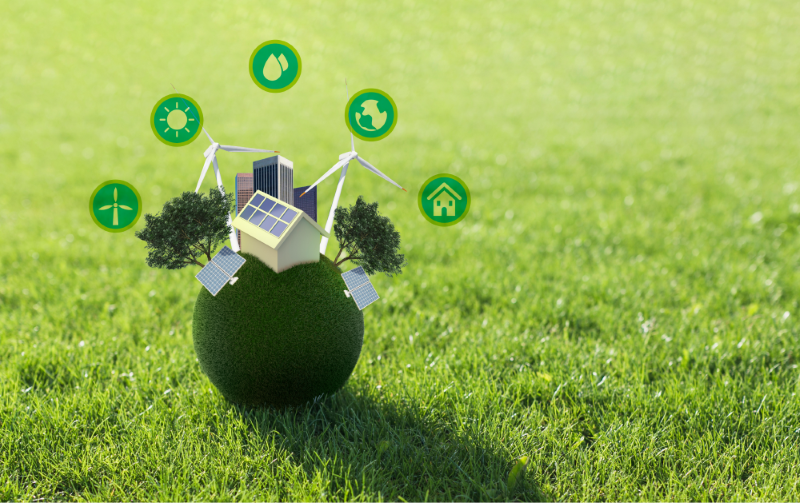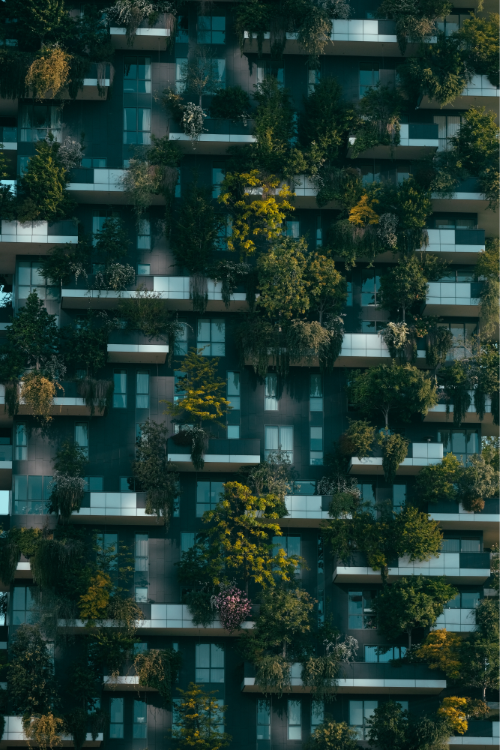So, how did we end up with these towering concrete monoliths? The Industrial Revolution serves as the foundation. People needed additional room as soon as the world’s population increased and became increasingly urbanized. It became a craze you may call “concrete fever.” Now, we’re not suggesting that concrete is a bad material. It’s used for foundations and walkways. But when a metropolis appears lifeless and gloomy, it may be time to reevaluate our architectural decisions.
Looking at our concrete creations without wondering how this drab metropolitan landscape affects our mental well-being is challenging. A life resembling a massive game of Tetris made of concrete isn’t the most excellent way to have a happy, balanced life. Even the most laid-back individuals may daydream about retiring to a lonely island due to the lack of greenery, wide spaces, and the continual fight for some space.
Green Dreams – Eco-Friendly Solutions
The first piece of advice for architectural Trends and design solutions is to utilize environmentally friendly and sustainable materials. Recovered wood, bamboo, and recycled steel are the new A-listers in the building industry. You won’t find them haunting landfills like a terrible breakup – they’re stylish and sustainable. Using the forces of nature to your advantage is the essence of innovative architecture. The green block includes solar panels, wind turbines, and energy-efficient architecture to make our buildings as energy-efficient as possible.

Not content to stop at energy and materials, we’re also bringing in the big guns: green spaces. Cities worldwide are becoming concrete jungles with a side of salad thanks to parks, rooftop gardens, and vertical forests. Finding a balance and designing areas that allow us to use contemporary urban amenities without compromising our relationship with the natural world are essential.
Smart Cities: Where Tech Meets Urban Chic
Technology is central in intelligent urban areas beyond its function as an assistant. Beginning with introducing energy-efficient buildings, we see buildings that continuously control temperature, lighting, and energy use, combine future design elements, and strive for ecological balance in modern architectural trends and design.
Now, let’s think about the field of data-driven design. This is far from a banal idea: picture all urban decisions, including garbage and traffic management, being well-informed by real-time data. This is the sophistication of a GPS-enabled city, brimming with information that fosters productivity and vibrancy for a city’s seamless operation.
Intelligent cities with both operational intelligence and visual appeal are what the future holds. This fusion of technology and design results in sustainable, effective, and essentially habitable urban environments. As we go on our adventure, picture an urban environment in which every structure is a technological wonder, and communal spirit goes beyond platitudes to become a way of life in cities. Keep checking for further details about the technology landscape influencing the future metropolis, including details about innovative tools such as team management software.
Sky’s the Limit: Redefining Vertical Living

In the middle of the majestic towers, there is a problem: unregulated high-rise buildings. But first, let’s explore the architecturally-driven solutions redefining vertical living: vertical gardens. Reintroducing flora into the concrete fabric of high-rises is not only an aesthetic decision but a calculated move. The flowing vegetation acts as a natural barrier and is a striking example of how urban growth and the natural world can live together.
Community areas housed behind the tall walls of skyscrapers come next. Common areas, rooftop gardens, and shared spaces replace the isolation sometimes associated with living in high rises. A counterweight to the isolation of living in a vertical city, these architectural interventions provide a sense of community and togetherness that transcends the physical structure.
In terms of structure, sustainability is paramount. Using environmentally friendly resources like recovered wood and repurposed steel becomes essential. There is a conscious drive to build with ecological responsibility in mind in addition to height. The skyscraper becomes a beacon of sustainable urban development and a symbol of environmental concern.
By rethinking high-rise living, modern architectural trends and design create vertical ecosystems rather than just tall buildings. The convergence of sustainable materials, vertical gardens, and community spaces redefines urban life. As the metropolitan skyline changes, it does so with the knowledge that creative architecture may improve how livable and functional these enormous buildings are. The skyscraper symbolizes the deliberate blending of ecological awareness, urban expansion, and a dedication to the community’s welfare. Stay tuned as we investigate more cutting-edge solutions for better urban life.
Timeless Meets Modern: Adapting Historical Architecture for Urban Living
A careful balancing act between history and current utility is required when embracing the art of modifying old buildings to meet the needs of contemporary urban living. Like adding digital accuracy to your grandmother’s old clock, it’s a contemporary touch that enhances its natural beauty.
The secret is to preserve the inherent charm of old buildings, such as their charming arches, elaborate facades, and cobblestone streets, which act as scenic backdrops and are fundamental to the character of old buildings. These aspects are priceless elements that give the urban environment personality and authenticity; they are by no means just visually appealing elements for Instagram.
To successfully integrate the past and current, careful design solutions are required. Instead of treating old lofts like museum pieces, the goal is to turn them into valuable areas that easily accommodate modern living. Open floor plans are envisaged, which honor the original architecture while satisfying the contemporary demand for roominess and an abundance of natural light—a break from the sense of being confined to the constraints of a bygone era.

